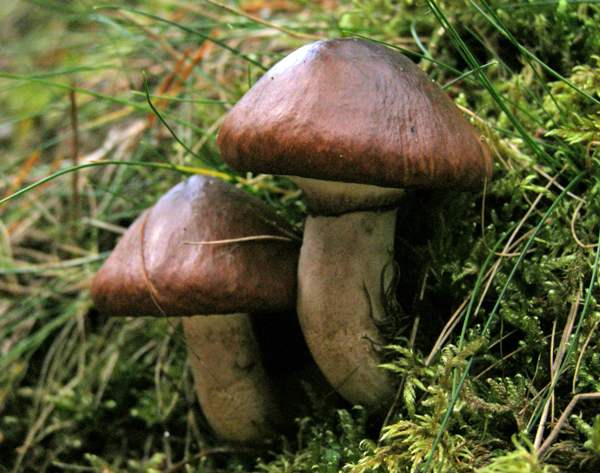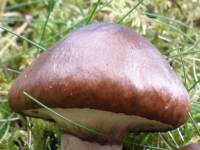Trees Birds Mammals Fish Amphibians Reptiles
Wild Algarve
Bookshop
Stropharia hornemannii (Fr.) S. Lundell & Nannf. - Conifer Roundhead
Phylum: Basidiomycota - Class: Agaricomycetes - Order: Agaricales - Family: Strophariaceae
Distribution - Taxonomic History - Etymology - Identification - Culinary Notes - Reference Sources

One of the most beautiful and elusive of pinewood mushrooms, the Conifer Roundhead grows on rotting pine stumps and pine branches buried in moss and needle litter. This is a 'roundhead' truly deserving of the name, as its cap does not flatten anything like as much as most roundheads do.
Distribution
In Britain this rare mushroom is known only from Scotland’s Caledonian Forest. Elsewhere in Europe it is very much a 'northern' species.
The Conifer Roundhead is also recorded in northern (mainly montane) regions of North America.
Taxonomic history
Although Christiaan Hendrik Persoon has described this mushroom as early a 1801 and called it Agaricus depilatus, its basionym (unique specific epithet that had not already been applied to another species) dates from 1818, when the great Swedish mycologist Elias Magnus Fries desribed the Conifer Roundhead scientifically and gave it the binomial name Agaricus hornemannii. In 1934 Swedish mycologists Seth Lundell (1892 - 1966) and John Axel Nannfeldt (1904 - 1985) transferred this species to the genus Stropharia, establishing its currently-accepted scientific name Stropharia hornemannii.
Synonyms of Stropharia hornemannii include Agaricus depilatus Pers., Agaricus hornemannii Fr., and Stropharia depilata (Pers.) Fr.
Etymology
Stropharia, the genus name, comes from the Greek word strophos meaning a belt, and it is a reference to the stem rings of fungi in this generic grouping. The specific epithet hornemanii is in honour of the Danish botanist Jens Wilken Hornemann (1770–1841).
Identification Guide
 |
Cap
7 -15cm across, domed with an inrolled margin, becoming broadly umbonate; usually violet brown, sometimes with yellow tints, but occasional specimens are creamy white; surface sticky when wet, drying silky smooth. |
| |
Gills
Adnate; fairly crowded; grey, becoming purple-brown at maturity.
Stem
7 to 12cm tall and 1 to 2cm diameter; smooth and white above ring zone; below ring covered in small white scales that become larger and more pronounced with age. |
| |
Spores
Ellipsoidal, smooth, 11-13 x 6-6.5μm, without a germ pore.
Spore print
Purple-brown. |
Odour/taste |
Not distinctive. |
Habitat & Ecological role |
Saprobic, on moss-covered rotting pine stumps and large branches buried in the forest floor. |
Season |
June to November in northern Britain. |
Similar species |
Panaeolus semiovatus also has a silky smooth cap, but it is much paler and grows on dung; its gills blacken to provide a black spore
print. |
Culinary Notes
Together with other fungi in the genus Stropharia, the Conifer Roundhead is generally considered inedible. Although, with the possible exception of Sulphur Tuft Hypholoma fasciculare, no member of the family Stropharicae is known to be dangerously poisonous, some of the Stropharia species can certainly cause very unpleasant gastro-intestinal symptoms. We therefore treat Stropharia hornemanii as just for looking, and definitely not for cooking.
Reference Sources
Fascinated by Fungi, 2nd Edition, Pat O'Reilly 2016, reprinted by Coch-y-bonddu Books in 2022.
BMS List of English Names for Fungi
Dictionary of the Fungi; Paul M. Kirk, Paul F. Cannon, David W. Minter and J. A. Stalpers; CABI, 2008
Taxonomic history and synonym information on these pages is drawn from many sources but in particular from the British Mycological Society's GB Checklist of Fungi.
Top of page...
Fascinated by Fungi. Back by popular demand, Pat O'Reilly's best-selling 450-page hardback book is available now. The latest second edition was republished with a sparkling new cover design in September 2022 by Coch-y-Bonddu Books. Full details and copies are available from the publisher's online bookshop...